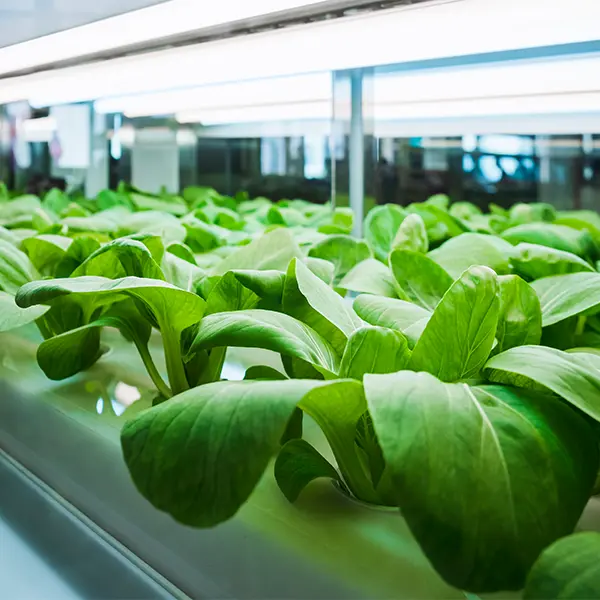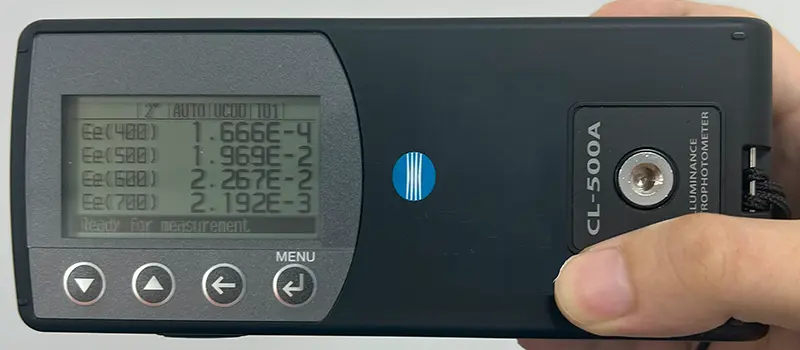The Importance of Light Meters in Indoor Farming

Indoor farming has transformed how we cultivate crops, enabling plants to thrive in controlled environments shielded from external weather fluctuations. For these systems to function effectively, indoor producers must meticulously monitor and regulate the factors that influence plant growth, with light being one of the most critical elements. Light is the driving force behind photosynthesis, the process by which plants convert light into energy.
Accurate light measurement ensures that plants receive the appropriate light intensity, quality, and duration necessary for photosynthesis, growth, and healthy crop yields. Artificial lights, such as LEDs, HPS (High-Pressure Sodium), etc., are utilized in an indoor farming setup to replicate sunlight. However, simply turning on the lights isn’t enough. Without proper light measurement, indoor producers risk providing either excessive light, which can cause heat stress and leaf damage, or insufficient light, which can hinder plant growth.
Ensuring Optimal Light for Plant Growth
The most important aspect of light for plant growth is Photosynthetically Active Radiation (PAR), which refers to the range of light wavelengths between 400 nm and 700 nm that plants utilize for the vital process of photosynthesis. Unlike sunlight, which provides a broad spectrum of light, artificial light sources can vary significantly in their spectral output, meaning some may emit more of certain wavelengths than others. Therefore, accurate light measurement is essential for indoor growers, allowing them to make informed adjustments to their lighting systems. This ensures that plants receive adequate PAR for effective photosynthesis, promoting healthy growth. Furthermore, indoor growers are able to assess how light is distributed across the growing spaces, ensuring even light distribution, which is critical for preventing areas of underexposure or overexposure that could hinder plant development.
Two important measurement concepts in indoor farming are the PPFD (Photosynthetic Photon Flux Density) and Daily Light Integral (DLI). PPFD refers to the amount of light, specifically within the PAR range, that reaches a plant’s surface every second. It is expressed in micromoles per square meter per second (µmol/m²/s), providing an instant snapshot of how much usable light is available for photosynthesis at any given moment. This metric is vital for growers to monitor, as it directly influences the plant’s ability to photosynthesize efficiently. DLI, on the other hand, measures the total quantity of PAR light that a plant receives over an entire day (24 hours). It is expressed in moles per square meter per day (mol/m²/day), and it accumulates the PPFD readings throughout the day to give an overall light exposure value. This metric holds great significance because plants rely on their total light exposure for growth and development, not just the momentary intensity of light. Each plant species has different DLI requirements, which can vary based on their growth stage and environmental conditions. For instance, fruiting crops like tomatoes typically require higher DLI levels compared to leafy greens to produce optimal yields. By understanding and optimizing DLI, indoor growers can significantly enhance not only the yield but also the overall health and vitality of their plants, leading to a more productive and successful indoor farming operation.
Konica Minolta Sensing Light Measurement Solutions for Indoor Farming

Konica Minolta Sensing, a leader in measurement solutions, provides a comprehensive range of light meters crucial for indoor growers who require accurate and reliable light measurements. Notably, the Konica Minolta Illuminance Spectrophotometer CL-500A excels in this area, offering the capability to measure spectral irradiance with a resolution of 1 nm across 360 to 780 nm wavelengths. This allows for the accurate calculation of the PPFD and DLI to monitor both the instantaneous intensity and total daily light the plants receive to ensure optimal light for effective photosynthesis.
Additionally, multiple Illuminance Spectrophotometer CL-500A units can be connected using the standard data management software CL-S10w, facilitating multi-point measurements to effectively assess light distribution to ensure that all areas of the growing space receive adequate light levels for healthy plant growth.
Alongside light measurement, Konica Minolta Sensing provides other measurement solutions designed to help indoor growers optimize their production processes. For example, the hyperspectral imaging cameras Specim FX and Specim IQ offer comprehensive insights into plant health indicators such as chlorophyll content, disease detection, and stress levels. Additionally, color measurement instruments like the Spectrophotometer CM-5 and the Chroma Meters CR-400 and CR-410 enable precise analysis and monitoring of the color and quality of produce. Explore our agriculture and food measurement solutions section to discover Konica Minolta Sensing’s comprehensive range of light, color, and SPAD measurement solutions, including hyperspectral imaging solutions, for the agriculture and food industry.
Need help choosing a suitable light meter or measurement solution for your indoor farming operation? Contact us for a complimentary consultation with our team of experts to guide you in selecting the right tools for your needs and help you optimize your indoor farming process.
